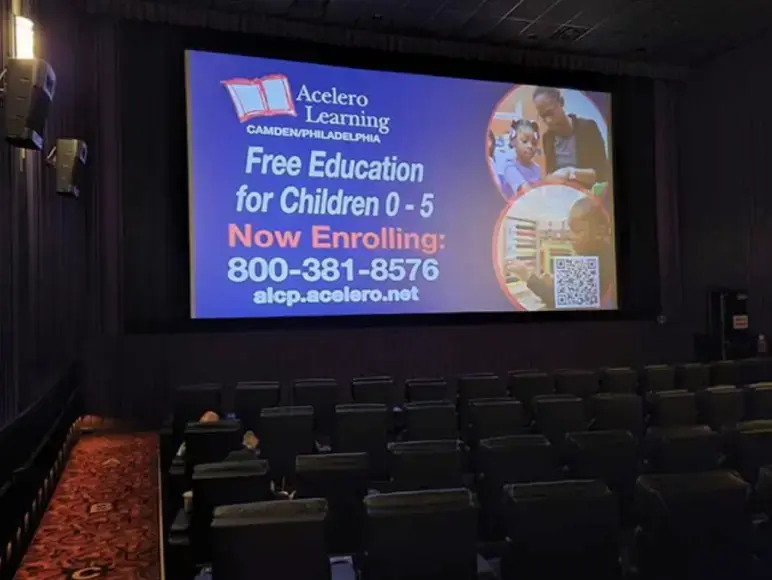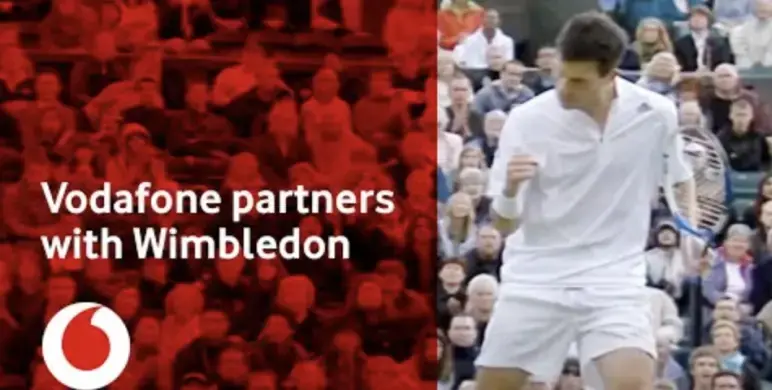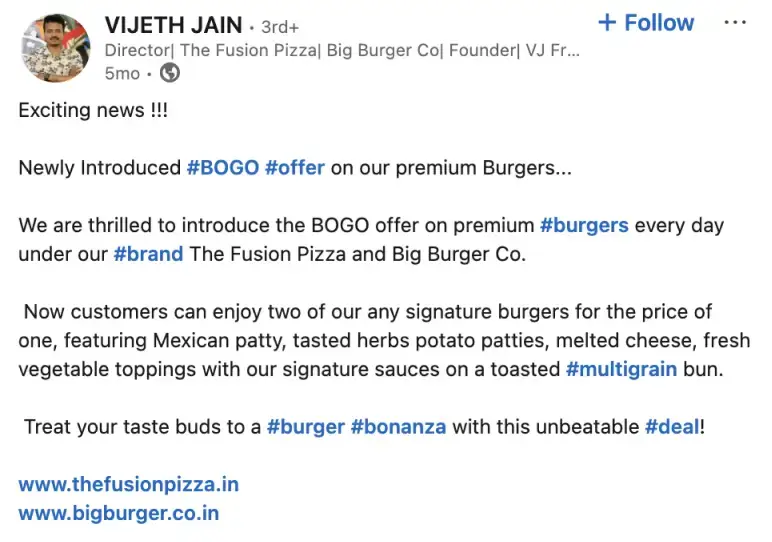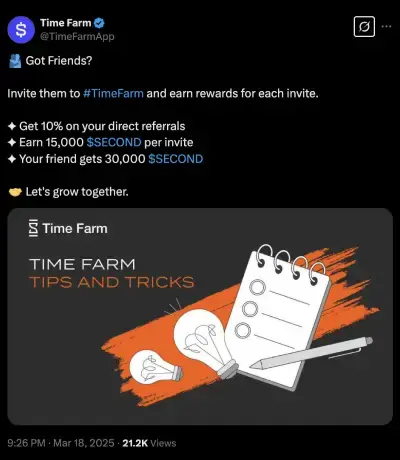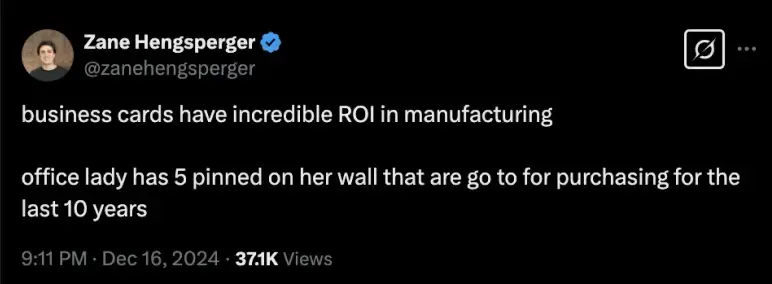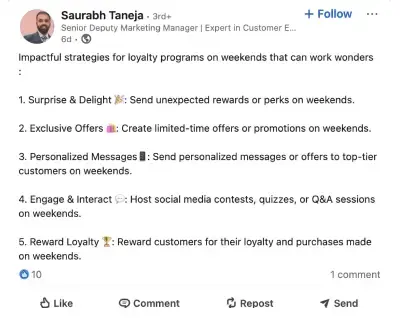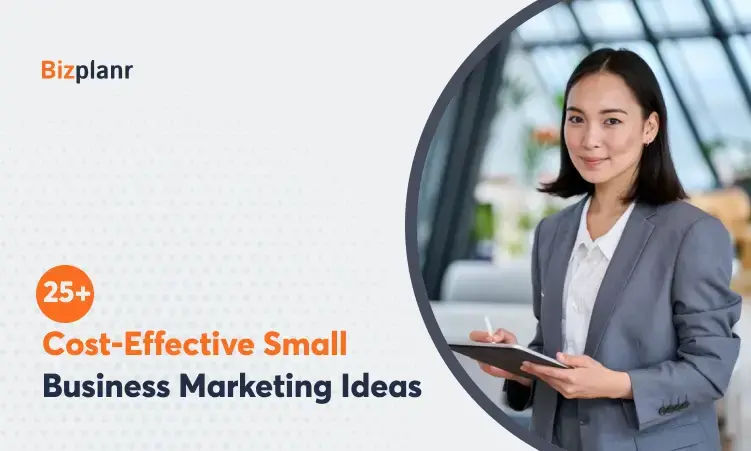YouTube, TikTok, Reels, and Instagram may have transformed the marketing landscape, but the power of timeless offline marketing ideas remains as strong as ever.
Businesses still run newspaper ads, you can still spot massive hoardings on highways, and see people distributing pamphlets on the streets.
The consistency and solid ROI of offline marketing are the reasons why many businesses continue to rely on it.
But here’s the real question: Which offline marketing ideas are the most effective? How should you use them strategically? And why are they still worth investing in?
This blog covers it all—from practical tips to real-world examples—so you can leverage offline marketing to grow your business with confidence.
Let’s get started.
What is offline marketing?
Offline marketing is any type of promotion you do in the real world without using an online platform. It’s the old-school way of reaching your audience directly through flyers, hoardings, pamphlets, and more.
For example, when you see a restaurant offering free food samples in a mall or a clothing store giving discounts through printed coupons—that’s offline marketing. It’s all about being visible where people are, in their day-to-day lives.
15+ Best offline marketing ideas
In this section, you’ll find some of the most effective offline marketing tactics that have delivered impressive results for many businesses. These are tried-and-tested strategies that have also helped us attract a solid audience.
Let’s dive in!
1) Pamphlet distribution
Pamphlet distribution is a classic and highly effective offline marketing tactic that has been around for years. It involves handing out small, informative flyers to promote your product, service, or special offer.
It’s a cost-effective marketing strategy and perfect for small businesses to quickly spread the word. Moreover, it’s highly effective because people physically hold the pamphlet, making them more likely to read it compared to online ads they often scroll past.
2) Vehicle branding
Vehicle branding is like moving billboards; wherever the vehicle goes, the product or service gets marketed. It’s one of the most impactful offline marketing techniques to attract and market to a specific region's audiences.
For example, a school bus promoting a new kids' play zone in the area. As it drives through school routes daily, it grabs the attention of parents and kids, making them curious to visit the play zone.
Here’s a real-life example of vehicle branding:
3) Community engagement
It’s one of the most common offline marketing efforts that modern businesses are practicing frequently. Community engagement involves actively participating in local events, causes, or activities to build trust and promote your brand.
For example,
Collaborator, a digital marketing marketplace, organizes an SEO event by inviting world-renowned SEO experts to share insights, collaborate, and introduce new strategies.
This not only positions Collaborator as an industry leader but also strengthens its community presence, attracting more people and boosting awareness of their work.
Suppose you have the business of species; you can partner with local restaurant owners for events and enhance your community engagement for your brand awareness.
4) On-screen advertisement
On-screen advertising involves displaying ads on cinema or event hall screens before or during shows. This offline marketing tactic helps small and local businesses gain mass exposure by reaching a captive audience in their area. It boosts brand visibility and encourages viewers to check out the business after the event.
Why this offline marketing strategy works:
- You get a captive audience—people are seated and focused, making the ad more impactful.
- It increases local brand visibility, especially in your target area.
- It creates immediate recall when people see your brand right before they head out.
5) Event sponsorship
It’s a smart offline advertising tactic that allows you to reach a specific, targeted audience effectively. For instance, if you own a sports-shoe manufacturing company and want to build brand awareness among athletes, you can sponsor a sporting event.
As a title sponsor, your brand name becomes part of the event’s identity. Every time the event is promoted, so is your brand.
For example, in 2022, Vodafone sponsored Wimbledon. As a result, the event was frequently referred to as “Vodafone Wimbledon.”
This constant mention gave Vodafone massive brand exposure, making it a familiar name among the audience and strengthening its market presence through offline marketing.
6) Newspaper ads
Newspaper ads are timeless and one of the most effective offline marketing strategies that continue to deliver results even in the digital age.
According to a survey, print advertisements achieve an average response rate of 9%. Whereas digital channels like email, paid search, and social media typically see only around 1%.
Newspaper advertising involves placing promotional content in print publications to reach a broad or local audience. You can choose from different ad formats—like display ads, classified ads, or full-page spreads—based on your goals and budget.
However, newspaper advertising is evolving with time. In an age where people are glued to reels, newspaper ads stay relevant by using innovative and creative strategies to capture attention.
Check out this innovative and interactive idea of Flipkart, an e-commerce platform that uses this timeless medium in an innovative way to reach its audience.
7) In-store promotions
In-store promotions are free offline marketing campaigns that boost sales without spending much on advertising or external marketing efforts. It’s a direct way to engage with people in real-time, giving them a reason to buy from you immediately.
Let me tell you how it works. Suppose you decide to run a “Buy One, Get One Free” (BOGO) offer for the weekend. As soon as customers walk in and see the promotion signs, they feel tempted to buy more because they know they’re getting extra value.
Interestingly, they end up buying more items than they originally planned, just to take advantage of the offer. That’s how in-store promotions work for your potential customers.
8) Referral programs
A referral program is an offline marketing strategy where you encourage existing customers to refer your business to their friends, family, or colleagues. In return, you offer them a reward or incentive—like discounts, freebies, or store credits.
It’s a brilliant offline marketing tactic to attract new customers without spending much on promotional campaigns. If you’re wondering how? Let me explain it to you with an example.
Suppose you run a gym. You launch a referral program offering one free month of membership to any member who brings in a new customer. The new customer also gets 10% off their first membership fee. Now, what happens?
Your existing members become your brand ambassadors, actively promoting your gym because they benefit from it. The new customer also feels they’re getting a deal, making them more likely to join. It’s a win-win for both sides—and your gym gains new clients without spending much on ads.
9) Press release
You might think, “Isn’t a press release an online marketing tactic?” Well, let me tell you—it started as an offline marketing method long before the internet existed. It was originally shared with newspapers, magazines, and media outlets in print form.
Fortunately, this medium is still in demand, where a short, official statement is shared with media outlets to announce news, events, or business updates. It’s a way to gain free publicity by getting your news featured in newspapers, magazines, radio, or TV.
10) Offer product samples
Offering free product samples is one of the smartest offline marketing efforts, especially for businesses like beauty products, food, beverages, and health supplements.
Brands distribute free samples in the market and ask people to try them and share their reviews.
Now, here’s why this tactic is so powerful:
- Customers who get free samples and like the product often become lifetime customers, returning for repeat purchases.
- Even if they don’t buy it immediately, they may talk about it with others, creating word-of-mouth marketing, which is priceless for any business.
That’s why free sample distribution is such an effective marketing technique. Many big companies use this strategy by offering free samples to gather customer feedback.
Based on the reviews, they refine and improve the product before launching it on a larger scale. You can also enhance the experience by pairing samples with small branded items or exploring creative merchandise ideas.
11) Business cards
You might think, “Who uses business cards when everything is online?”
But let me tell you—business cards are far from outdated. They’re a personal, memorable, and cost-effective way to promote yourself and your business offline.
Let me place you in a situation: You’re at a networking event or a business meeting, and you had a great conversation with a potential customer or partner.
Now, instead of just saying,
“I’ll email you my contact info.” You hand them a sleek, well-designed business card. That card now becomes a physical reminder of your meeting.
- Even if you forget to send a follow-up email, the customer still has your contact details and can reach out to you anytime.
- Moreover, unlike digital contact exchanges that are easily forgotten, a physical card sticks around.
- Plus, it shows you’re prepared, professional, and serious about what you do.
A business card should have just the right amount of information:
- Your full name and job title
- Business name and logo
- Phone number, email, and website
- Your physical address (if you have a store or office)
- Social media handles (if relevant)
12) Loyalty programs
Loyalty programs are one of the clever offline marketing strategies that many successful businesses use. A loyalty program is a reward system designed to encourage existing business. It’s a way of saying,
“Hey, thanks for shopping with us! Come back, and you’ll get something extra.”
By offering exclusive perks, discounts, or freebies to returning customers, you build trust, increase retention, enhance your customer base, and boost sales.
Let’s understand the loyalty programs with an example. Imagine there’s a local coffee shop you visit regularly. They have a loyalty card program where:
For every 5 coffees you buy, you get the 6th one free. It might seem like a small reward, but guess what? It keeps you coming back instead of trying other cafes. Why? Because you know you’re earning something extra with each visit, making it worth your while.
Moreover, this offline method is the most effective way to foster brand loyalty and create a solid loyal customer base.
Remember, if you want to get the maximum out of this customer loyalty program:
- Don’t complicate the process
- Allow customers to sign up quickly
- Offer exclusive discounts or cashback
- Include loyalty program flyers in shopping bags
Need loyalty program strategies? Check this post:
13) Send seasonal cards and gifts
Sending seasonal cards and gifts is one of the best offline marketing strategies I recommend. It’s about connecting with your customers, making them feel valued, and bringing your brand into their minds.
The idea is simple:
You send personalized cards or small gifts to your customers during festive seasons, on special occasions, or even on their birthdays.
It’s not just about selling—it’s about strengthening relationships and showing that you care beyond the transaction.
Let me give an example:
At my business, we have many clients, and while working with them, we naturally collect their basic information, like their birthdays, blood groups, qualifications. and anniversaries.
So, what we do is send them a small gift on their birthday.
- This creates an emotional bond with the client.
- They feel valued and respected.
- And most importantly, our brand stays on their mind, making them more likely to choose us again.
It’s a simple yet thoughtful gesture that strengthens the relationship and builds loyalty.
14) Organize an event
It’s the most impactful offline marketing strategy that modern businesses are adopting nowadays.
Organizing an event simply means creating a platform where you bring people together—whether it’s your existing customers, potential clients, or industry experts.
The event could be:
- A product launch
- A workshop or seminar
- An industry networking event
- A customer appreciation day
- A charity or fundraising event
Through this, you get to interact with your audience, showcase your expertise, and leave a lasting impression.
For example,
Such a marketing strategy by Semrush attracts hundreds of people, and it receives media coverage and word-of-mouth publicity, which boosts its visibility.
Moreover, organizing such events increases brand awareness, helps you get to interact with industry professionals, and generate buzz in the market.
15) Get air on local radio and TV
It is one of the most proven offline marketing techniques that has helped many SMEs reach thousands of potential customers within their region in a short time. Similar to online marketing, this traditional method simply means promoting your business through broadcast media, either by:
- Running paid ads on local radio or TV stations
- Being featured in a local news segment or talk show
- Participating in interviews or podcasts
- Sponsoring a local TV program or radio show
Like local newspaper ads, radio ads are affordable and impactful, making them ideal for local businesses. Here’s how you should do it right:
- Pick a radio station that your target audience listens to.
- To maximize reach, run your ads during peak hours (7–9 AM and 5–7 PM)
- Keep your ad short, clear, and catchy—ideally 30–60 seconds.
16) Have a booth at the trade show
If you want to get your business noticed offline, having a booth at a trade show is a powerful marketing move. It puts you right in front of potential customers, industry experts, and even investors.
Moreover, having a booth helps you grow your business network, connect with more customers, and increase sales.
Remember, unlike digital marketing, trade shows create real-world experiences. You can physically connect with your audience, share creative ideas, and boost brand recognition.
Here are a few tips that you should follow when you set up a booth at a trade show:
- Use bold signage, clear branding, and product displays to attract foot traffic.
- Offer product demos or free samples to engage visitors.
- Hand out promotional materials like flyers, brochures, or branded merchandise so people remember you.
- Your brand message should clearly communicate who you are, what you offer, and why it matters
17) Billboards
Billboards are a powerful offline marketing tool that offers massive visibility. According to a survey, around 20% of billboard viewers visit a business after seeing an ad, and 74% of those visits lead to a purchase.
Billboards are strategically placed in high-traffic areas, where drivers, pedestrians, and thousands of people see them daily. Unlike online marketing, it doesn’t fade away in a heap of content but provides consistent exposure.
But billboards today are no longer static like they used to be. With digitalization, they now use digital signage to become more dynamic and impactful.
What makes billboards more effective than digital marketing?
- Billboards offer 24/7 exposure
- Unlike digital ads, billboards can’t be skipped or blocked
- Capture the attention of a wider audience daily
- More visually striking and easier to remember
Wrapping up
That’s enough from my end. In this blog, we covered more than 15 types of offline marketing ideas that actually work. One thing is certain with these strategies—offline marketing is far from outdated. In fact, it remains one of the most genuine and effective ways to build real connections with people.
However, before diving into any non-digital marketing ideas, ensure they support your overall business plan. With the right approach and strategies, you will gain a good ROI as well as see tangible growth in your business.
And if you’re looking for a simpler way to craft a business plan, consider using Bizplanr. It’s an AI-driven business plan generator platform that crafts business plans in minutes.
Nevertheless, I hope you found these creative offline marketing ideas insightful and feel inspired to try them out in your business.
Stay tuned for more updates!
Get Your Business Plan Ready In Minutes
Answer a few questions, and AI will generate a detailed business plan.
Frequently Asked Questions
How can I promote my business using offline marketing ideas?
You can use billboards, flyers, cross-promotions with other local businesses, and trade shows to boost your visibility.
Are offline marketing strategies still effective in 2025?
Yes, offline strategies like networking events, direct mail, and local sponsorships remain highly effective for building trust and brand recognition.
How can I collaborate with other local businesses for cross-promotion?
You can partner with complementary businesses to offer bundle deals, co-branded events, or referral programs—expanding your reach at low cost.
Is offline marketing cost-effective for small businesses?
Yes, offline marketing definitely offer cost effectiveness. Tactics like flyer distribution, local partnerships, and free consultations offer great ROI.
Can I combine offline marketing with digital strategies?
Absolutely! Combining offline ideas with digital strategies, like QR codes on flyers or social media mentions, boosts engagement and reach.




